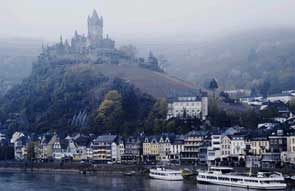As many as 20,000 total miles of inland waterways let travelers absorb European culture at a relaxed, leisurely and up-close pace.
A traveler can journey Europe’s waterways in a variety of ways. River cruising most often refers to river going cruise ships typically carrying fewer than 250 passengers. As such, river cruising ships are much smaller than mass-market, ocean-going vessels, but as river boats go, are on the larger end of the scale. Western and Central Europe have many river routes to offer the larger cruise boats. Popular itineraries include the Danube visiting Hungary, Austria and Germany and the Elbe River through Germany and the Czech Republic. In France, the Rhone and the Soane meander through Provence and Burgundy, while the Seine takes passengers through Paris and Giverny. In Northern Italy, the Po offers exciting opportunities with a variety of river cruise companies. Finally, the Volga, connecting St. Petersburg and Moscow provides a decidedly different way to port between these two magnificent cities. Relaxation and intensive sightseeing are the main activities, as organized entertainment is somewhat limited on most river cruises, except for the occasional lecture or sing-along. Mostly, the crew allows passengers to enjoy their time as they see fit.
Many first time river cruisers are delighted to discover that, unlike ocean cruising, there is very little boat motion. The mandated slow speeds and flat waters of the rivers ensure a quiet, placid voyage. It is often difficult when not on deck to even know the vessel is underway!
Meals have always been a special part of cruising, and river cruises have maintained that tradition. On river cruise vessels, food is a key part of the experience, prepared by a dedicated chef, the ship’s captain, or a restaurateur in a small village. Europeans take great pride in their culinary skills, and practically everyone who has ever cruised along the rivers and canals of Europe has at least one story about an unforgettable meal or food experience. Special dietary considerations can often be accommodated if requested early in the booking process.
The peak season for river cruising is much the same as European travel in general, late spring through mid-fall and early November. The shoulder season, a real value, ranges from early March through mid-May. The autumn months coincide with grape season, and several cruise lines are fully booked during this time by wine connoisseurs. Finally, April is tulip season and cruises in and around the Netherlands are particularly popular then.















